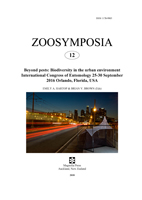Abstract
A sample of the 100 most cited papers on urban insect ecology from 2000-2017 is reviewed. This period represents the time since a call for more research on urban arthropods was raised by McIntyre (2000). Only literature on urbanization and its effects on insects were examined. Most studies concentrated on habitat suitability, beetles, butterflies, and bees.
References
Bolger, D. T., Suarez, A.V., Crooks, K.R., Morrison, S.A. & Case, T.J. (2000) Arthropods in urban habitat fragments in southern California: area, age, and edge effects. Ecological Applications, 10, 1230–1248.
https://doi.org/10.1890/1051-0761(2000)010[1230:AIUHFI]2.0.CO;2
Burghardt, K.T., Tallamy, D.W. & Shriver, G. (2009) Impact of native plants on bird and butterfly biodiversity in suburban landscapes. Conservation Biology, 23, 219–224.
https://doi.org/10.1111/j.1523-1739.2008.01076.x
Colla, S.R. & MacIvor, J.S. (2017) Questioning public perception, conservation policy, and recovery actions for honeybees in North America. Conservation Biology, 31, 1202–1204.
https://doi.org/10.1111/cobi.12839
Fattorini, S. (2016) Insects and the city: what island biogeography tells us about insect conservation in urban areas. Web Ecology, 16, 41–45.
https://doi.org/10.5194/we-16-41-2016
Gaston, K.J., Smith, R.M., Thompson, K. & Warren, P.H. (2005) Urban domestic gardens (II): experimental tests of methods for increasing biodiversity. Biodiversity and Conservation, 14, 395–413.
https://doi.org/10.1007/s10531-004-6066-x
Gibb, H. & Hochuli, D.F. (2001) Habitat fragmentation in an urban environment: large and small fragments support different arthropod assemblages. Biological Conservation, 106.
Grimm, N.B., Grove, J., Pickett, S.T.A. & Redman, C.L. (2000) Integrated approaches to long-term studies of urban ecological systems: urban ecological systems present multiple challenges to ecologists—pervasive human impact and extreme heterogeneity of cities, and the need to integrate social and ecological approaches, concepts, and theory. BioScience, 50, 571–584.
https://doi.org/10.1641/0006-3568(2000)050[0571:IATLTO]2.0.CO;2
Hartop, E.A., Brown, B.V. & Disney, R.H.L. (2015) Opportunity in our ignorance: urban biodiversity study reveals 30 new species and one new Nearctic record for Megaselia (Diptera: Phoridae) in Los Angeles (California, USA). Zootaxa, 3941, 451–484.
https://doi.org/10.11646/zootaxa.3941.4.1
Hartop, E.A., Brown, B.V. & Disney, R.H.L. (2016) New flies from L.A., The Sequel: Twelve further new species of Megaselia (Diptera: Phoridae) from the BioSCAN Project in Los Angeles (California, USA). Biodiversity Data Journal, 4.
https://doi.org/10.3897/BDJ.4.e7756
Helden, A.J., Stamp, G.C. & Leather, S.R. (2012) Urban biodiversity: comparison of insect assemblages on native and non-native trees. Urban Ecosystems, 15, 611–624.
https://doi.org/10.1007/s11252-012-0231-x
Ishitani, M., Kotze, D.J. & Niemelä, J. (2003) Changes in carabid beetle assemblages across an urban-rural gradient in Japan. Ecography, 27, 481–489.
https://doi.org/10.1034/j.1600-0587.2003.03436.x
Lindroth, C.H. (1957) The faunal connections between Europe and North America, vol. Almqvist & Wiksell/ John Wiley & Sons, Stockholm & New York.
https://doi.org/10.5962/bhl.title.6759
MacIvor, J.S. & Packer, L. (2017) ‘Bee hotels’ as tools for native pollinator conservation: a premature verdict? PLoS One.
https://doi.org/10.1371/journal.pone.0122126
Mata, L., Threlfall, C.G., Williams, N.S.G., Hahs, A.K., Malipatil, M., Stork, N.E. & Livesley, S.J. (2017) Conserving herbivorous and predatory insects in urban green spaces. Scientific Reports, 7: 40970.
https://doi.org/10.1038/srep40970
Matteson, K.C. & Langellotto, G.A. (2010) Small scale additions of native plants fail to increase beneficial insect richness in urban gardens. Insect Conservation and Diversity, 4, 89–98.
https://doi.org/10.1111/j.1752-4598.2010.00103.x
McIntyre, N.E. (2000) Ecology of urban arthropods: a review and a call to action. Annals of the Entomological Society of America, 93, 825–835.
https://doi.org/10.1603/0013-8746(2000)093[0825:EOUAAR]2.0.CO;2
McKinney, M.L. (2006) Urbanization as a major cause of biotic homogenization. Biological Conservation, 127, 247–260.
https://doi.org/10.1016/j.biocon.2005.09.005
McKinney, M.L. (2008) Effects of urbanization on species richness: a review of plants and animals. Urban Ecosystems, 11, 161–176.
https://doi.org/10.1007/s11252-007-0045-4
Moore, A.A. & Palmer, M.A. (2005) Invertebrate biodiversity in agricultural and urban headwater streams: implications for conservation and management. Ecological Applications, 15, 1169–1177.
https://doi.org/10.1890/04-1484
Niemelä, J., Saarela, S.R., Söderman, T., Kopperoinen, L., Yli-Pelkonen, V., Väre, S. & Kotze, D.J. (2010) Using the ecosystem services approach for better planning and conservation of urban green spaces: a Finland case study. Biodiversity and Conservation, 19, 3225–3243.
https://doi.org/10.1007/s10531-010-9888-8
Niemelä, J., Kotze, J., Ashworth, A., Brandmayr, P., Desender, K., New, T., Penev, L, Samways, M. & Spence, J. (2000) The search for common anthropogenic impacts on biodiversity: a global network. Journal of Insect Conservation, 4, 3–9.
https://doi.org/10.1023/A:1009655127440
Owen, J. (1991) The ecology of a garden, vol. Cambridge University Press, Cambridge.
Pardee, G. L. & Philpott, S.M. (2014) Native plants are the bee’s knees: local and landscape predictors of bee richness and abundance in backyard gardensd. Urban Ecosystems, 17, 641–659.
https://doi.org/10.1007/s11252-014-0349-0
Rainio, J. & Niemelä, J. (2003) Ground beetles (Coleoptera: Carabidae) as bioindicators. Biodiversity and Conservation, 12, 487–506.
https://doi.org/10.1023/A:1022412617568
Satterfield, D.A., Maerz, J.C. & Altizer, S. (2015) Loss of migratory behaviour increases infection risk for a butterfly host. Proceedings of the Royal Society, B.
https://doi.org/10.1098/rspb.2014.1734
Shapiro, A.M. (2002) The Californian urban butterfly fauna is dependent on alien plants.
Smith, R.M., Warren, P.H., Thompson, K. & Gaston, K.J. (2006) Urban domestic gardens (VI): environmental correlates of invertebrate species richness. Biodiversity and Conservation, 15 (8), 2415–2438.
https://doi.org/10.1007/s10531-004-5014-0
Threlfall, C.G., Mata, L., Mackie, J.A., Hahs, A.K., Stork, N.E., Williams, N.S.G. & Livesley, S.J. (2017) Increasing biodiversity in urban green spaces through simple vegetation interventions. Journal of Applied Ecology, 54, 1874–1883.
https://doi.org/10.1111/1365-2664.12876

